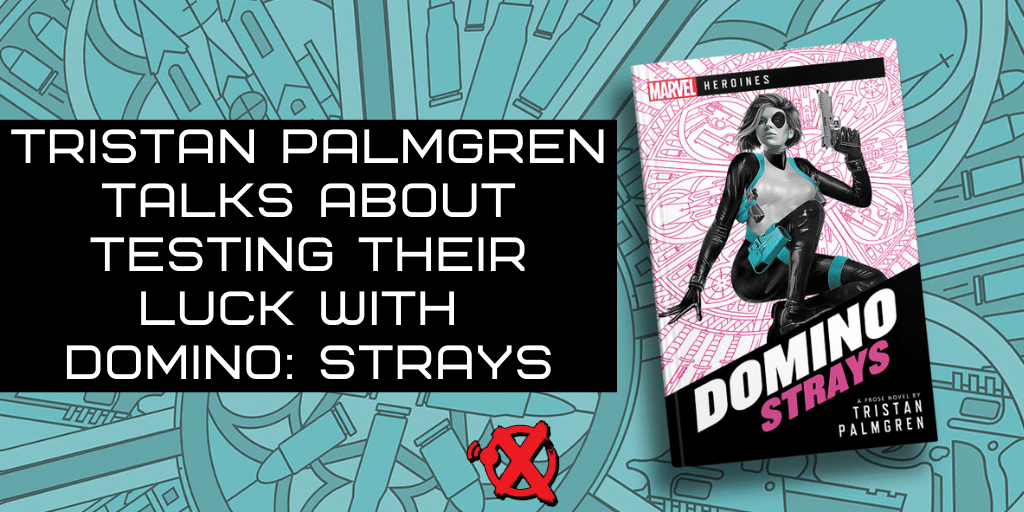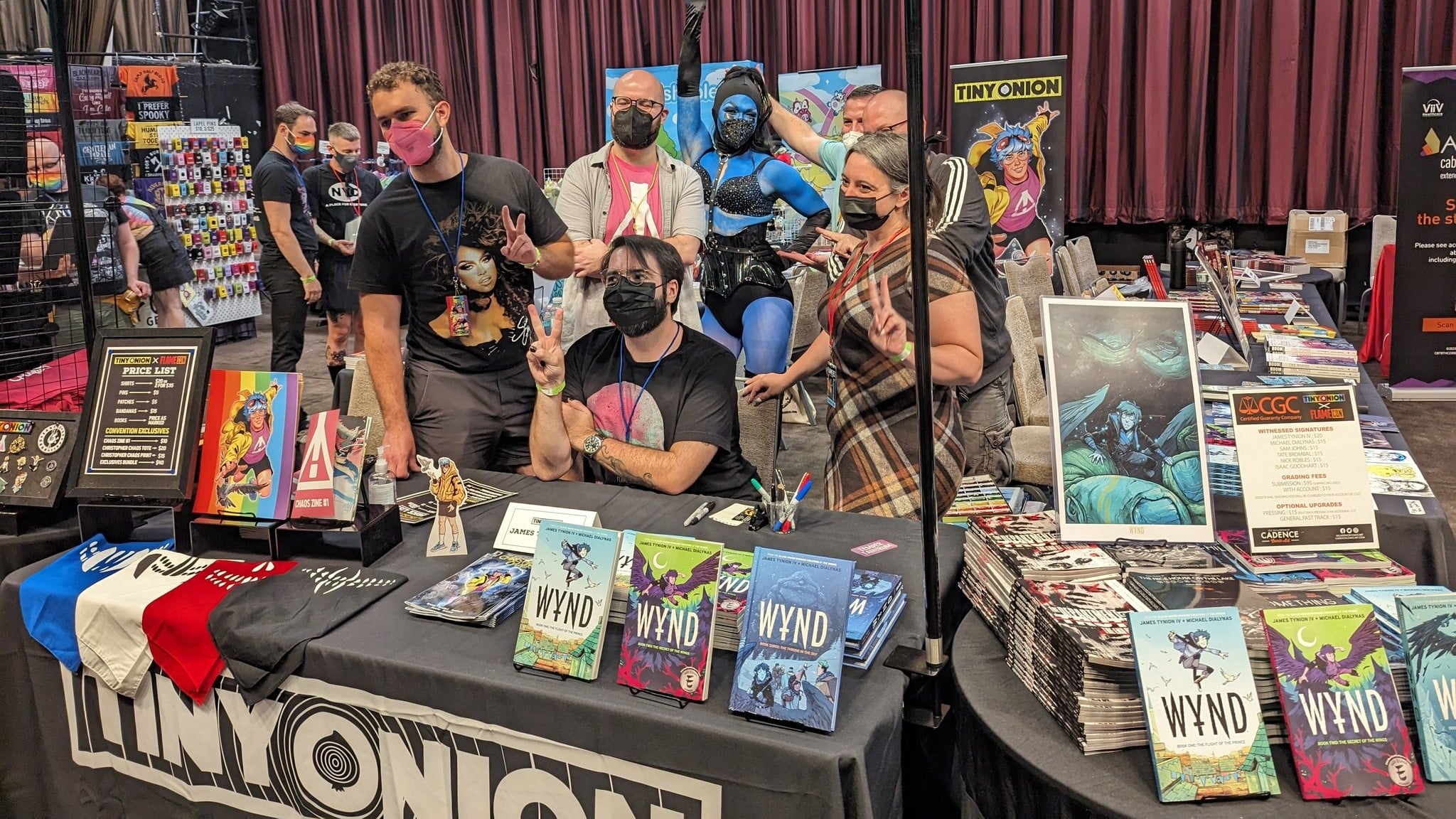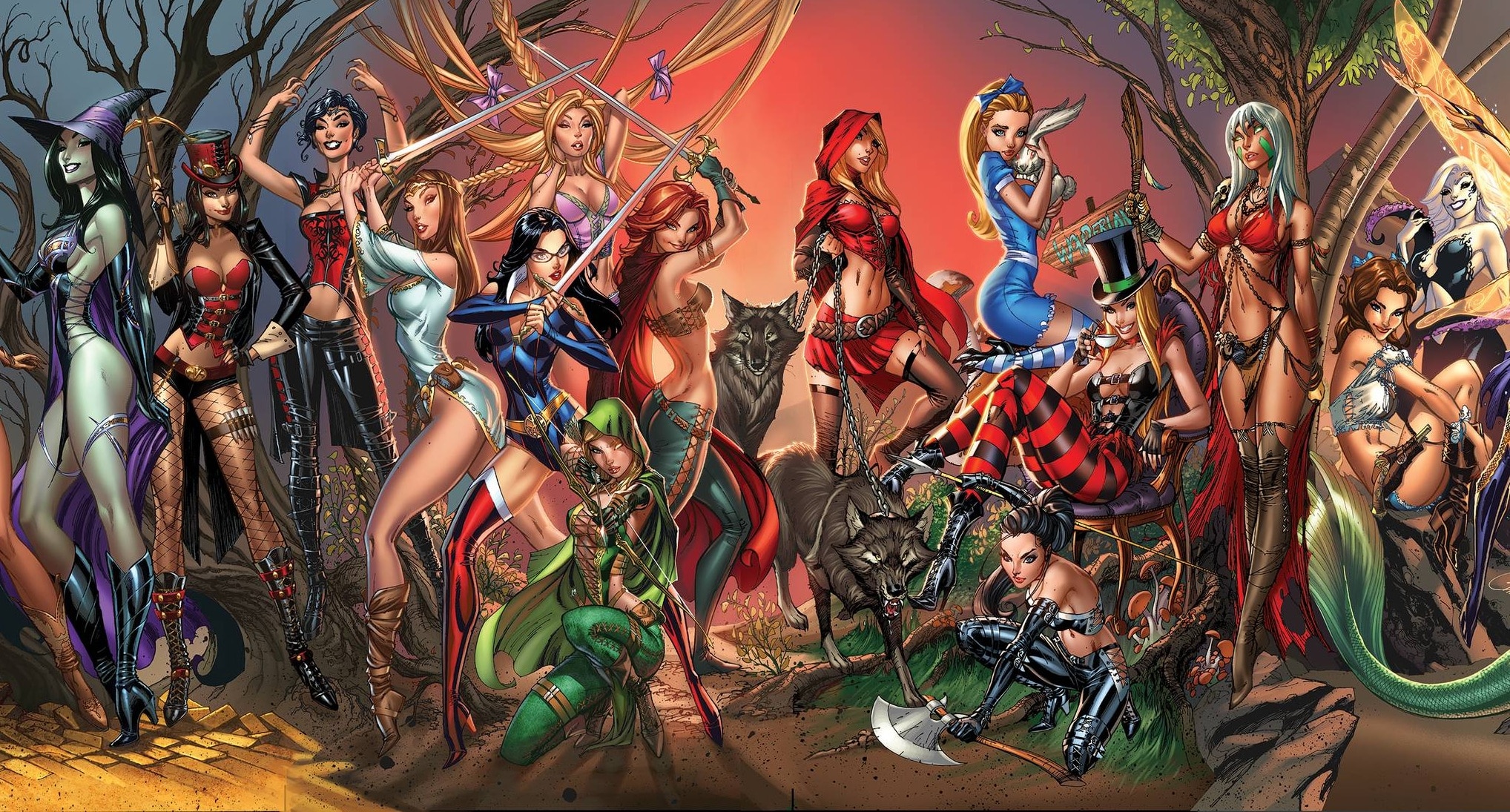Tristan Palmgren is a Sci-Fi/Fantasy writer of the upcoming Domino: Strays, coming out on October 6th, 2020. Their debut novel Quietus, a genre-warping blend of historical fiction and space opera set during the Black Death, was published by Angry Robot Books March, 2018. The sequel, Terminus, was released in November, 2018. Andrea Ayers of Xavier Files sat down with Tristan to talk about Domino, X-Men, and juggling the launch of a new line of books.

Xavier Files: Before this book, what was your relationship with Domino, X-Force, and Marvel as a whole?
Tristan Palmgren: Honestly? I didn’t have much. I’m a newcomer to the X-Men family of media, but I’ve had a blast jumping in. There aren’t enough professions that will let you spend your afternoons reading comics and call it work, but I highly recommend finding one.
XF: This is the first in Aconyte’s Marvel Heroines line. What made Domino the right choice to lead off this line?
TP: I was looking for someone dynamic, someone whose abilities would be fun to write, and someone with a sharp, witty voice. Marvel has no shortage of characters that fit all of these. Since I wanted this to be a first-person novel, though, voice was exceedingly important. The most important. I started reading Gail Simone & David Baldeón’s 2018 Domino – and its followup, 2019s Domino: Hotshots – and fell in love with Domino’s voice. A first-person prose novel gives us a lot of time to spend with that voice. Domino is the kind of character that, the more I learned about, the more I wanted to know. She’s delightful.

Domino’s abilities in particular seemed like they would work well in a prose novel. Domino’s luck-based powers can be flashy (I mean, just watch her introduction in Deadpool 2), but they also need a clear narrative establishing one coincidence pinging into another and into another. Since showing things in motion can be tricky in comics, writing Domino in prose let me set up Rube Goldberg machines of violence.
XF: One area where I think Domino Strays shines is in its depiction of action, can you describe that process (and any challenges you had)?
TP: I love writing kinetic action scenes where action follows consequence follows consequence follows consequence. Domino’s ability to manipulate luck was made for that. The opportunity to write big, complicated, frenetic cause-and-effect chains drew me to this project. An action scene with Domino is one in which bullets ricochet at unlikely angles, the right punches get thrown at the wrong moments, and every plan falls apart a second into execution. I’ve been crafting scenes like that since I started writing, and Domino’s skills and power gave me a good excuse to take it even more over-the-top.
XF: We go back and forth between Domino’s past and present, how did you balance revealing parts of her past without taking readers out of the action of the present?
TP: The focus of the narrative may shift from past to present, but the narrator, Domino, is telling this story in real time. Her time. She’s telling the story in this order because it’s the order that makes sense to her. And that’s what guided me. The ideas she’s chasing flow right from one time period to the next.
XF: It’s refreshing to see Domino as leading her own narrative here, especially since fans of hers tend to only get bits and pieces of her next to Cable or Deadpool; did it feel like you had a lot of pressure to live up to expectations? If so, can you speak to how you handled this?
With this, like with any shared universe work, there’s a lot of pressure to meet expectations and get things “right.” (I hope I was successful, though readers get the final call on that.) I can’t read every X-Men comic in existence – I doubt anyone ever could – but I could read a lot of Domino, take a lot of notes, and understand what makes her tick and what makes her appealing.
But understanding is a first step, but not the last. Respect is even more important. Respect for all the work that went into everything that came before, on the writing and art and editorial fronts. Respect for the characters. And respect for the readers who love them.
XF: We get a lot of frankness from Domino here, the direct discussion with the reader feels like a level of vulnerability not normally allowed (especially with comic book heroes).
“I’m not gonna lie. Not in these pages. I’m plenty insecure, a lot of the time. First, best step to being stronger is to recognize that.
And I’m strong as hell – which means facing down all those kinds of insecurities. Constantly. With a dead eye.
And a dead aim.”
Was it important for Domino to speak directly to the reader this way, and if so why?
TP: This novel had a first-person narrator from its conception. I have trouble imagining it any other way. One of the big advantages of adapting comic characters to prose is having the space to show off more of their voice. I started with the voice before the plot, the setting, continuity, or anything else developed.
I sometimes have difficulty starting a novel, or finding the right narrative voice. Not with Strays. Domino’s voice was as fun for me to write as I hope it is to read. And she does show some vulnerability, but, as in that excerpt, those vulnerabilities also have a way of highlighting her strengths.
XF: How’d you choose the squad Domino is seen teaming up with here? I think people might be surprised at Black Widow taking a kind of second fiddle position here, are you ready for that haha?
TP: I can’t take any credit for Domino’s team. All of the characters featured here were already working with her, either in 2018’s Domino or 2019’s Hotshot series–both written by Gail Simone. The Domino series had her working with her partners Outlaw and Diamondback, and introduced Atlas Bear later on. Hotshots brought Black Widow and White Fox into the posse.

I had fun writing Black Widow, but, you’re right, she’s not the central character here. I’d love to spend more time with this team and all its members in future projects.
XF: This book has many callbacks and relationships from the recent Gail Simone & David Baldeón comic series. What led to the choice to set the story in such a specific continuity rather than a more generic one?
TP: When I started outlining Domino: Strays, I wasn’t sure if Aconyte’s line of Marvel prose novels was going to be tied into the main Marvel continuity or if we were starting our own. Though we eventually decided on the latter, I wanted to make sure that readers who most recently met Domino through the 2018 and 2019 series didn’t feel like those stories were already being rebooted. (Reboot fatigue is real.) Though there are some differences between Earth-616 and the world in Aconyte’s books, the more recent Domino series can still be assumed to have happened.

There’s also the fact that sorting out continuities and entangling past events and characters is a comic book tradition. Domino: Strays works without any knowledge of past comics, but it also didn’t feel like it would be a comic book adaptation without playing into that tradition. I wanted to make sure that new readers could connect with Domino’s history, and feel like she has a life outside of these pages.
XF: Domino jumps between different teams and various histories how did you manage navigating that complexity?
TP: The online writing community draws distinctions between “plotters” and “pantsers”–people who create outlines before they plot, and people who write by the seat of their pants. I’ve always been a plotter, and I had an outline in hand for this story before I started the first chapter. With a story like this, juggling timelines and alternating cliffhangers, I needed it. I have a hard time remembering the names of people I met five seconds ago.
XF: Domino: Strays is very much a personal redemption story, she is trying to save her past self (sort-to-speak) in addition to accomplishing her mission… does that sound right to you? If so, how might her return to Chicago and what she does there influence future Domino stories and timelines?
TP: That sounds close to right. It’s difficult to get into specifics without spoilers, but she’s trying to understand the decisions her past self has made as much as redeem them–and see if she would make the same decision all over again. If she’s happy with who she is.
I’ve got plans for Domino, but her next adventures are going to take her far from Chicago. But I doubt the people and the plot threads she’s left there are done with her.
DOMINO: STRAYS by Tristan Palmgren

[Marvel Heroines] Sharp-witted, luck-wrangling mercenary Domino takes on both a dangerous cult and her own dark past, in this explosive introduction to the new series of Marvel prose novels.
The job: infiltrate a Chicago conman’s cult to liberate some brainwashed twins. For former X-Force operative Domino, that’s a “hell no”. Fanatics are bad news. She still has nightmares about Project Armageddon, the super-soldier program that wrecked her life and destroyed her family. If only she’d had someone to help her back then, someone… like her. It’s a total pain in the ass, but maybe it is time to finally face those demons. With her probability manipulating superpowers she can turn even the worst of situations to her advantage.
Pub Date: Oct 6th, 2020
Trade paperback • ISBN 978-1-83908-050-0 • US$16.95 • CAN$22.95 • UK£8.99
Ebook • ISBN 978-1-83908-051-7 • US$9.95 • CAN$13.95 • UK£7.99
Andrea Ayres is a freelance writer and pop culture journalist.






